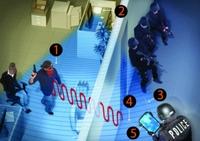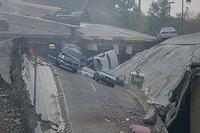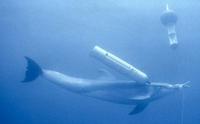-
Wynyard Group takes New Zealand Police forensics solution global
Developed in 2007, New Zealand Police technology called EVE (Environment for Virtualized Evidence) allows enforcement officers rapidly to analyze seized electronic goods such as mobile phones, PCs, and other storage devices for evidence and intelligence
-
-
Improved disaster resilience is imperative for U.S: report
A new report from the National Academies says that it is essential for the United States to bolster resilience to natural and human-caused disasters, and that this will require complementary federal policies and locally driven actions that center on a national vision – a culture of resilience; improving resilience should be seen as a long-term process, but it can be coordinated around measurable short-term goals that will allow communities better to prepare and plan for, withstand, recover from, and adapt to adverse events
-
-
Seeing through walls with the help of laser systems
Inspired by the erratic behavior of photons zooming around and bouncing off objects and walls inside a room, researchers combined these bouncing photons with advanced optics to enable them to “see” what is hidden around the corner
-
-
UAVs with dexterous arms to help in infrastructure repair and disaster recovery
With current technology, most UAVs perform passive tasks such as surveillance and reconnaissance missions, tasks which are performed well above ground; researchers are interested in how UAVs might interact with objects at or near ground level; a UAV with dexterous arms could perform a wide range of active near-ground missions, from infrastructure repair and disaster recovery to border inspection and agricultural handling
-
-
Seeing through walls, clearly

Research and tests show, for the first time, the ability to use t passive WiFi radar for through-the-wall (TTW) detection of moving personnel – and do so covertly
-
-
New forensic tool automates RAM forensic investigations
New tool enables computer forensic investigators to analyze and make use of information contained in volatile memory; memory analysis produces important, case-relevant data for investigators that cannot be obtained from disk analysis, such as running applications, open files, and active network connections
-
-
Canadian company offers the first treatment to neutralize red mud

Red mud is the most significant waste product of the traditional Bayer process for aluminum production; the industry produces more than 100 million tons of red mud a year, of which less than 5 percent is be reused; the rest is stored in ponds and reservoirs, posing serious environmental and economic risk; on 4 October 2010, for example, a flood of toxic red mud devastated Hungary after a retaining dyke ruptured, causing an ecological disaster; Canadian company Orbite Aluminae offers a technology to tackle the aluminum industry’s most serious problem
-
-
Improving landmine detection – and air travel safety

It is estimated that there are about 110 million active landmines lurking underground in sixty-four countries across the globe; each year as many as 25,000 people, most of them civilians, are maimed or killed by landmines; the mines not only kill and maim, they can paralyze communities by limiting the use of land for farming and roads for trade; researchers offer a better way to detect landmines – a method which can also be used in airports to help thwart possible terrorist threats
-
-
Improving oil recovery, aiding environmental cleanup
Researchers have taken a new look at an old, but seldom-used technique developed by the petroleum industry to recover oil, and learned more about why it works, how it could be improved, and how it might be able to make a comeback not only in oil recovery but also environmental cleanup
-
-
New, affordable instant warnings of bridge collapse

The Federal Bureau of Transportation lists nearly 70,000 U.S. bridges as “structurally deficient,” requiring extra surveillance; in addition, more than 77,000 others are categorized as “obsolete” — exceeding their intended lifespan and carrying loads greater than they were designed to handle; researchers developed a new technology for monitoring these 150,000 aging U.S. highway bridges
-
-
A second look at off-shore use of vertical-axis wind turbines

Wind energy researchers are re-evaluating vertical axis wind turbines (VAWTs) to help solve some of the problems of generating energy from offshore breezes; though VAWTs have been around since the earliest days of wind energy research, VAWT architecture could transform offshore wind technology
-
-
A device used to measure nuclear weapons effects is now used for rocket propulsion system
Can a device formerly used to test nuclear weapons effects find a new life in rocket propulsion research? That is the question in which researchers seek an answer; when assembled, the device will tip the scales at nearly fifty tons, and will be “one of the largest, most powerful pulse power systems in the academic world,” according to one researcher
-
-
Researchers say spoofed GPS signals can be countered
From cars to commercial airplanes to military drones, global positioning system (GPS) technology is everywhere — and researchers have known for years that it can be hacked, or as they call it, “spoofed”; the best defense, they say, is to create countermeasures that unscrupulous GPS spoofers can not deceive
-
-
Milestone for a Raytheon bomb which acquires, tracks, and then hits moving targets
Raytheon said its Small Diameter Bomb II (SDB II) program achieved a milestone when it successfully engaged and hit a moving target during a flight test at the White Sands Missile Range, New Mexico; the bomb, released from an F-15E, acquired, tracked, and guided to a moving target using its tri-mode seeker, scoring a direct hit
-
-
Using dolphins’ signal processing method for sea-mine detection

One way for Iran to close the Straits of Hormuz to shipping is to place thousands of sea mines in the water; research examine how dolphins process their sonar signals, using the findings to provide a new system for man-made sonar to detect targets, such as sea mines, in bubbly water
-
More headlines
The long view
Risk Assessment with Machine Learning
Researchers utilize geological survey data and machine learning algorithms for accurately predicting liquefaction risk in earthquake-prone areas.
Bookshelf: Smartphones Shape War in Hyperconnected World
The smartphone is helping to shape the conduct and representation of contemporary war. A new book argues that as an operative device, the smartphone is now “being used as a central weapon of war.”
New Approach Detects Adversarial Attacks in Multimodal AI Systems
New vulnerabilities have emerged with the rapid advancement and adoption of multimodal foundational AI models, significantly expanding the potential for cybersecurity attacks. Topological signatures key to revealing attacks, identifying origins of threats.
